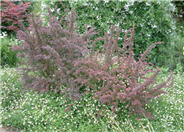
Common name:Red Leaf Japanese Barberry
Botanical name:Berberis thunbergii 'Atropurpurea'
A thorny, deciduous shrub growing 4'-6' high and as wide, Red Japanese Barberry can be contained with some light pruning. Its purplish-red leaves contrast beautifully against a dark green background.
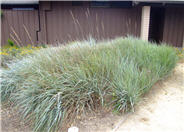
Common name:Canyon Prince Wild Rye
Botanical name:Leymus condensatus 'Canyon Prince'
One of the best known and utilized native grass selections in Southern California, this beautiful, blue gray foliage spreads out 3'-4' or more. It will reach a height of 2'-3'. It rarely flowers. It does spread by rhizomes although not as vigorously as some closely related species. It can be extremely drought tolerant and care must be taken not to over water this species as it can rot from the center. Otherwise, it is carefree and requires virtually no maintenance.
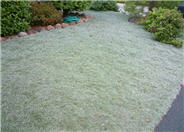
Common name:Dymondia, Rock Ditty
Botanical name:Dymondia margaretae
This foliage is gray/green/silvery; it is a very dense, mat forming ground cover. It tolerates drought, cold, salt spray and poor soils. It's deep rooted and produces small, inconspicuous yellow flowers. Rock Ditty is great for use in between stepping stones or pavers.
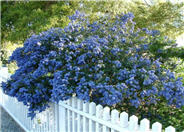
Common name:Concha California Lilac
Botanical name:Ceanothus 'Concha'
Concha is a lilac that grows 6'-8' in height and width. It has small narrow leaves with intense dark blue flower clusters in spring. It is tolerant of coastal and inland conditions.
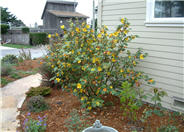
Common name:California Glory Flannel Bush
Botanical name:Fremontodendron 'California Glory'
'California Glory' is an open and spreading evergreen shrub 10'-20' in height with many yellow flowers blooming in spring. It needs good drainage and little summer water. It is a native plant to California as the name suggests and it is drought tolerant.
Sustainable Fertilization
If you mulch heavily as recommended in the compost and mulch fact sheets you should not need traditional fertilization. Sustainable landscapes fertilize themselves as soil organisms break down and recycle the dropped leaves into nutrients.
Click in the green box for more information
| Designer: Jeffrey Gordon Smith | Path Through the Grass |
Photographer: GardenSoft |
Soils and Compost:
Physical weed control, including mulching, or hand removal protects the watershed from harmful chemicals.
Water Saving Tip:
Be sure to fix all leaks promptly no matter how small they may seem.
Integrated Pest Management:
Drip and other smart irrigation delivers water directly to roots, allowing no excess water for weeds.
